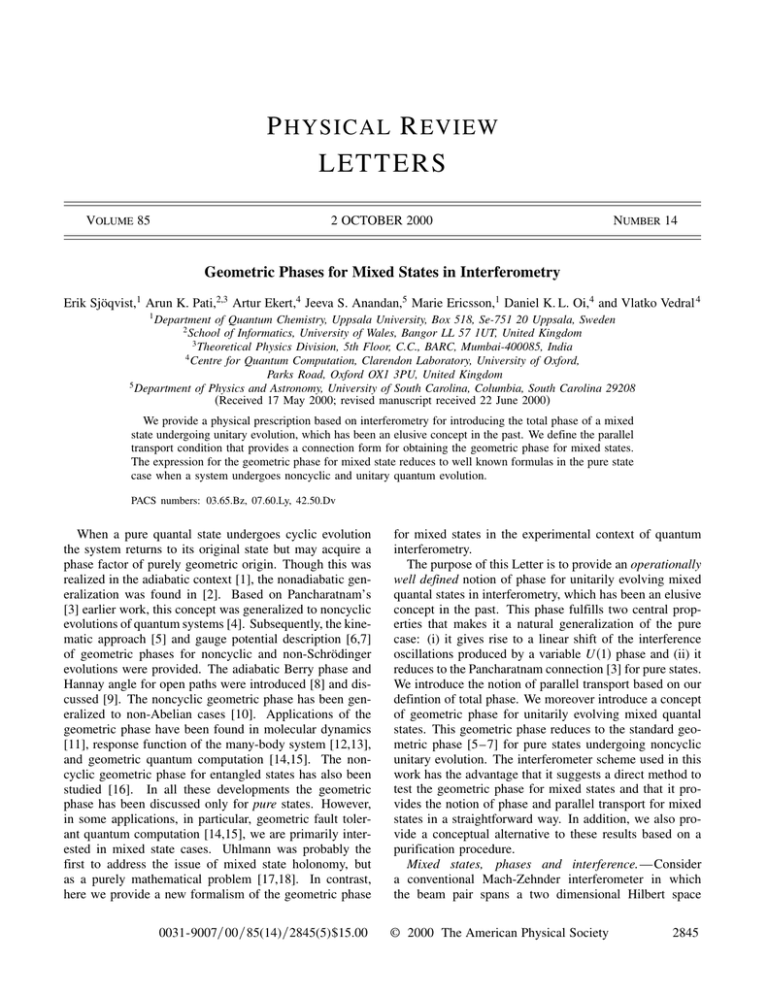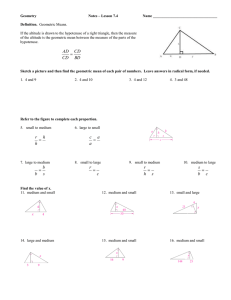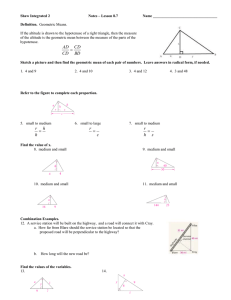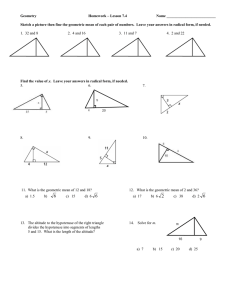P R L E T T E R S HYSICAL
advertisement

P HYSICAL R EVIEW LETTERS VOLUME 85 2 OCTOBER 2000 NUMBER 14 Geometric Phases for Mixed States in Interferometry Erik Sjöqvist,1 Arun K. Pati,2,3 Artur Ekert,4 Jeeva S. Anandan,5 Marie Ericsson,1 Daniel K. L. Oi,4 and Vlatko Vedral 4 1 Department of Quantum Chemistry, Uppsala University, Box 518, Se-751 20 Uppsala, Sweden 2 School of Informatics, University of Wales, Bangor LL 57 1UT, United Kingdom 3 Theoretical Physics Division, 5th Floor, C.C., BARC, Mumbai-400085, India 4 Centre for Quantum Computation, Clarendon Laboratory, University of Oxford, Parks Road, Oxford OX1 3PU, United Kingdom 5 Department of Physics and Astronomy, University of South Carolina, Columbia, South Carolina 29208 (Received 17 May 2000; revised manuscript received 22 June 2000) We provide a physical prescription based on interferometry for introducing the total phase of a mixed state undergoing unitary evolution, which has been an elusive concept in the past. We define the parallel transport condition that provides a connection form for obtaining the geometric phase for mixed states. The expression for the geometric phase for mixed state reduces to well known formulas in the pure state case when a system undergoes noncyclic and unitary quantum evolution. PACS numbers: 03.65.Bz, 07.60.Ly, 42.50.Dv When a pure quantal state undergoes cyclic evolution the system returns to its original state but may acquire a phase factor of purely geometric origin. Though this was realized in the adiabatic context [1], the nonadiabatic generalization was found in [2]. Based on Pancharatnam’s [3] earlier work, this concept was generalized to noncyclic evolutions of quantum systems [4]. Subsequently, the kinematic approach [5] and gauge potential description [6,7] of geometric phases for noncyclic and non-Schrödinger evolutions were provided. The adiabatic Berry phase and Hannay angle for open paths were introduced [8] and discussed [9]. The noncyclic geometric phase has been generalized to non-Abelian cases [10]. Applications of the geometric phase have been found in molecular dynamics [11], response function of the many-body system [12,13], and geometric quantum computation [14,15]. The noncyclic geometric phase for entangled states has also been studied [16]. In all these developments the geometric phase has been discussed only for pure states. However, in some applications, in particular, geometric fault tolerant quantum computation [14,15], we are primarily interested in mixed state cases. Uhlmann was probably the first to address the issue of mixed state holonomy, but as a purely mathematical problem [17,18]. In contrast, here we provide a new formalism of the geometric phase 0031-9007兾00兾85(14)兾2845(5)$15.00 for mixed states in the experimental context of quantum interferometry. The purpose of this Letter is to provide an operationally well defined notion of phase for unitarily evolving mixed quantal states in interferometry, which has been an elusive concept in the past. This phase fulfills two central properties that makes it a natural generalization of the pure case: (i) it gives rise to a linear shift of the interference oscillations produced by a variable U共1兲 phase and (ii) it reduces to the Pancharatnam connection [3] for pure states. We introduce the notion of parallel transport based on our defintion of total phase. We moreover introduce a concept of geometric phase for unitarily evolving mixed quantal states. This geometric phase reduces to the standard geometric phase [5–7] for pure states undergoing noncyclic unitary evolution. The interferometer scheme used in this work has the advantage that it suggests a direct method to test the geometric phase for mixed states and that it provides the notion of phase and parallel transport for mixed states in a straightforward way. In addition, we also provide a conceptual alternative to these results based on a purification procedure. Mixed states, phases and interference.—Consider a conventional Mach-Zehnder interferometer in which the beam pair spans a two dimensional Hilbert space © 2000 The American Physical Society 2845 VOLUME 85, NUMBER 14 PHYSICAL REVIEW LETTERS ˜ 苷 兵j0̃典, j1̃典其. The state vectors j0̃典 and j1̃典 can be taken H as wave packets that move in two given directions defined by the geometry of the interferometer. In this basis, we may represent mirrors, beam splitters, and relative U共1兲 phase shifts by the unitary operators µ ∂ µ ∂ 1 1 i 0 1 ŨM 苷 , ŨB 苷 p , 1 0 2 i 1 (1) ∂ µ eix 0 , Ũ共1兲 苷 0 1 respectively. An input pure state r̃in 苷 j0̃典 具0̃j of the interferometer transforms into the output state r̃out 苷 y y y ŨB ŨM Ũ共1兲ŨB r̃in ŨB Ũ y 共1兲ŨM ŨB 1 苷 2 µ 1 1 cosx 2i sinx i sinx 1 2 cosx ∂ (2) that yields the intensity along j0̃典 as I ~ 1 1 cosx. Thus the relative U共1兲 phase x could be observed in the output signal of the interferometer. Now assume that the particles carry additional internal degrees of freedom, e.g., spin. This internal spin space Hi ⬵ C N is spanned by the vectors jk典, k 苷 1, 2, . . . , N, chosen so that the associated density operator is initially diagonal, X r0 苷 wk jk典 具kj , (3) ∂ µ ∂ y 1 1 1 21 out ≠ Ui r0 Ui 1 ≠ r0 1 1 21 1 µ ∂ y 1 1 ≠ r0 U i 1 eix 21 21 µ ∂ ∏ 2ix 1 21 ≠ Ui r0 . (7) 1e 1 21 The output intensity along j0̃典 is 1 苷 4 ∑µ y y r0 ! Ui r0 Ui , (4) with Ui a unitary transformation acting only on the internal degrees of freedom. Mirrors and beam splitters are assumed to leave the internal state unchanged so that we may replace ŨM and ŨB by UM 苷 ŨM ≠ 1i and UB 苷 ŨB ≠ 1i , respectively, 1i being the internal unit operator. Furthermore, we introduce the unitary transformation µ ∂ ∂ µ 0 0 eix 0 U苷 ≠ Ui 1 ≠ 1i . (5) 0 1 0 0 The operators UM , UB , and U act on the full Hilbert space ˜ ≠ H . U corresponds to the application of U along H i i the j1̃典 path and the U共1兲 phase x similarly along j0̃典. We use U to generalize the notion of phase to unitarily evolving mixed states. Let an incoming state given by the density matrix in 苷 r̃in ≠ r0 苷 j0̃典 具0̃j ≠ r0 be split coherently by a beam splitter and recombine at a second beam splitter after being reflected by two mirrors. Suppose that U is applied between the first beam splitter and the mirror pair. The incoming state transforms into the output state y y y out 苷 UB UM UUB in UB U y UM UB . Inserting Eqs. (1) and (5) into Eq. (6) yields 2846 (6) y I ~ Tr共Ui r0 Ui 1 r0 1 e2ix Ui r0 1 eix r0 Ui 兲 ~ 1 1 jTr共Ui r0 兲j cos关x 2 arg Tr共Ui r0 兲兴 , y Tr共r0 Ui 兲 (8) ⴱ 苷 关Tr共Ui r0 兲兴 . where we have used The important observation from Eq. (8) is that the interference oscillations produced by the variable U共1兲 phase x is shifted by f 苷 arg Tr共Ui r0 兲 for any internal input state r0 , be it mixed or pure. This phase difference reduces for pure states r0 苷 jc0 典 具c0 j to the Pancharatnam phase difference between Ui jc0 典 and jc0 典. These two latter facts are the central properties for f being a natural generalization of the pure state phase. Moreover, the visibility of the interference pattern is n 苷 jTr共Ui r0 兲j $ 0, which reduces to the expected n 苷 j具c0 jUi jc0 典j for pure states. The output intensity in Eq. (8) may be understood as an incoherent weighted average of pure state interference profiles as follows. The state k gives rise to the interference profile [19,20] k with wk the classical probability to find a member of the ensemble in the pure state jk典. The density operator could be made to change inside the interferometer 2 OCTOBER 2000 Ik ~ 1 1 nk cos关x 2 fk 兴 , (9) where nk 苷 j具kjUi jk典j and fk 苷 arg具kjUi jk典. This yields the total output intensity X X I 苷 (10) wk I k ~ 1 1 wk nk cos关x 2 fk 兴 , k k which is the incoherent classical average of the above single-state interference profiles weighted by the corresponding probabilities wk . Equation (10) may be written in the desired form 1 1 ñ cos共x 2 f̃兲 by making the identifications µX ∂ ifk f̃ 苷 arg wk nk e 苷 arg Tr共Ui r0 兲 苷 f , ñ 苷 ÇX k wk n k e ifk Ç (11) 苷 jTr共Ui r0 兲j 苷 n . k Parallel transport condition and geometric phase.— Consider a continuous unitary transformation of the mixed state given by r共t兲 苷 U共t兲r0 U y 共t兲. (From now on, we omit the subscript “i” of U.) We say that the state of the system r共t兲 acquires a phase with respect to r0 if arg Tr关U共t兲r0 兴 is nonvanishing. Now if we want to parallel transport a mixed state r共t兲 along an arbitrary path, then at each instant of time the state must be in phase with the state at an infinitesimal time. The state at time t 1 dt is related to the state at time t as r共t 1 dt兲 苷 U共t 1 dt兲U y 共t兲r共t兲U共t兲U y 共t 1 dt兲. Therefore, the phase difference between r共t兲 and VOLUME 85, NUMBER 14 PHYSICAL REVIEW LETTERS r共t 1 dt兲 is arg Tr关r共t兲U共t 1 dt兲U y 共t兲兴. We can say r共t兲 and r共t 1 dt兲 are in phase if Tr关r共t兲U共t 1 dt兲U y 共t兲兴 is real and positive. This condition can be regarded as a generalization of Pancharatnam’s connection from pure to mixed states. However, from normalization y ᠨ and Hermiticity of r共t兲 it follows that Tr关r共t兲U共t兲U 共t兲兴 is purely imaginary. Hence the above mixed state generalization of Pancharatnam’s connection can be met only when y ᠨ Tr关r共t兲U共t兲U 共t兲兴 苷 0 . (12) This is the parallel transport condition for mixed states undergoing unitary evolution. On the space of density matrices the above condition can be translated to Tr关r dU U y 兴 苷 0, where d is the exterior derivative on the space of density operators. However, r共t兲 determines the N 3 N matrix U共t兲 (N being the dimension of the Hilbert space) up to N phase factors, and the single condition Eq. (12) while necessary is not sufficient to determine U共t兲. These N phase factors are fixed by the N parallel transport condition [19] y ᠨ 具k共t兲jU共t兲U 共t兲 jk共t兲典 苷 0, k 苷 1, 2, . . . , N , (13) where the jk共t兲典’s are orthonormal eigenstates of r共t兲. These are sufficient to determine the parallel transport operator U共t兲 if we are given a nondegenerate density matrix r共t兲. The parallel transport condition for a mixed state provides us a connection in the space of density operators which can be used to define the geometric phase. Thus a mixed state can acquire pure geometric phase if it undergoes parallel transport along an arbitrary curve. One can check that if we have a pure state density operator r共t兲 苷 jc共t兲典 具c共t兲典 then the parallel transport condition ᠨ Eq. (12) reduces to 具c共t兲 j c共t兲典 苷 0 as has been discussed in [2,4–7,21,22] which is both necessary and sufficient. Now we can define a geometric phase for mixed state evolution. Let the state trace out an open unitary curve G: t [ 关0, t兴 ! r共t兲 苷 U共t兲r0 U y 共t兲 in the space of density operators with “end points” r共0兲 苷 r0 and r共t兲, where U共t兲 satisfies Eq. (12). The evolution need not be cyclic, i.e., r共t兲 fi r0 . We can naturally assign a geometric phase gg 关G兴 to this curve once we notice that the dynamical phase vanishes identically. The dynamical phase is the time integral of the average of Hamiltonian and can be defined as 1 Z t gd 苷 2 dt Tr关r共t兲H共t兲兴 h̄ 0 Z t ᠨ 苷 2i dt Tr关r0 U y 共t兲U共t兲兴 . (14) 0 Since the density matrix undergoes parallel transport evolution the dynamical phase vanishes identically. Moreover, the parallel transport operator U共t兲 should fulfill the stronger condition Eq. (13). Thus the geometric phase for a mixed state is defined as 2 OCTOBER 2000 µX gg 关G兴 苷 f 苷 arg Tr关r0 U共t兲兴 苷 arg wk nk e ibk ∂ , k (15) where exp共ibk 兲 are geometric phase factors associated with the individual pure state paths in the given ensemble. The above geometric phase can be given a gauge potential description such that the line integral will give the open path geometric phase for mixed state evolution. Indeed the mixed state holonomy can be expressed as Z ᠨ gg 关G兴 苷 dt i Tr关r0 W y 共t兲W共t兲兴 苷 Z G i Tr关r0 W y dW兴 苷 Z V, (16) G where W共t兲 苷 Tr关r0 U y 共t兲兴 U共t兲 jTr关r0 U y 共t兲兴j (17) and U共t兲 satisfies (13). The quantity V 苷 i Tr关r0 W y dW兴 can be regarded as a gauge potential on the space of density operators pertaining to the system. The geometric phase defined above is manifestly gauge invariant; it does not depend explicitly on the dynamics, but it depends only on the geometry of the open unitary path G in the space of density operators pertaining to the system. It is also independent of the rate at which the system is transported in the quantum state space. The geometric phase Eq. (16) can also be expressed in terms of an average connection form Z X Z X gg 关G兴 苷 wk i具xk j dxk 典 苷 wk Vk , (18) G k G k where Vk is the connection form and jxk 共t兲典 苷 W共t兲 jk典 is the “reference section” for the kth component in the ensemble. To be sure, what we have defined is consistent with known results; we can check that this expression reduces to the standard geometric phase [5–7] Z t ᠨ (19) gg 关G兴 苷 arg具c共0兲 j c共t兲典 苷 dt i具x共t兲 j x共t兲典 0 for a pure state r共t兲 苷 jc共t兲典 具c共t兲j when it satisfies parallel transport condition. Here, jx共t兲典 is a reference state, which gives the generalized connection one form [6,7]. Purification.—An alternative approach to the above results is given by lifting the mixed state into a purified state jC典 by attaching an ancilla. It is known that any mixed state can be obtained by tracing out some degrees of freedom of a larger system which was in a pure state Xp jC典 苷 wk jk典s jk典a , (20) k where jk典a is a basis in an auxiliary Hilbert space, describing everything else apart from the spatial and the spin degrees of freedom. The existence of the above purification requires that the dimensionality of the auxiliary Hilbert 2847 VOLUME 85, NUMBER 14 PHYSICAL REVIEW LETTERS space is at least as large as that of the internal Hilbert space. If jC典 is the state at time t 苷 0 and it is transformed to jC共t兲典 by a local unitary operator U共t兲 苷 Us 共t兲 ≠ Ia then jC共t兲典 苷 Xp wk Us 共t兲 jk典s jk典a . (21) 2 OCTOBER 2000 Ç Ç ∑ ∏ V V I ~ 11 cos cos x 2 arg cos 2 2 V 苷 1 1 cos cosx . 2 (27) k The inner product of the initial and the final state 具C共0兲 j C共t兲典 苷 X wk 具kjU共t兲 jk典 苷 Tr关U共t兲r0 兴 (22) k gives the full description of the modified interference. Indeed by comparing Eqs. (8) and (22), we see that arg具C共0兲 j C共t兲典 is the phase shift and j具C共0兲 j C共t兲典j is the visibility of the output intensity obtained in an interferometer. The parallel transport condition, given by Eq. (12), follows immediately from the pure state case when applied to any purification of r0 , i.e., ᠨ 0 苷 具C共t兲 j C共t兲典 苷 X ᠨ jk典 wk 具kjU y 共t兲U共t兲 k y ᠨ ᠨ 苷 Tr关r0 U y 共t兲U共t兲兴 苷 Tr关r共t兲U共t兲U 共t兲兴 . (23) Thus a parallel transport of a density operator r共t兲 amounts to a parallel transport of any of its purifications. Example.—Consider a qubit (a spin- 12 particle) whose density matrix can be written as r苷 1 共1 1 r r̂ ? s 兲 , 2 (24) where r̂ is a unit vector and r is the constant for unitary evolution. The pure states r 苷 1 define the unit Bloch sphere containing the mixed states r , 1. Suppose that during the time evolution r̂ traces out a curve on the Bloch sphere that subtends a geodesically closed solid angle V [21]. The two pure states j6; r̂ ? s 典 acquire noncyclic geometric phase 7V兾2 and identical visibility n1 苷 n2 ⬅ h. Using Eq. (15) we obtain the geometric phase for G ∂ µ V . (25) f 苷 gg 关G兴 苷 2 arctan r tan 2 The visibility n 苷 jTr共Ur0 兲j is given by s V V n 苷 h cos2 1 r 2 sin2 . 2 2 (26) For cyclic evolution we have h 苷 1 but the mixed state n fi 1 due to the square root factor on the right-hand side of Eq. (26). Moreover, Eqs. (25) and (26) reduce to the usual expressions for pure states f 苷 2V兾2 and n 苷 h by letting r 苷 1. In the case of maximally mixed states r 苷 0 we obtain f 苷 arg cos共V兾2兲 and n 苷 j cos共V兾2兲j. Thus the output intensity for such states is 2848 Early experiments [23–25] to test the 4p symmetry of spinors utilized unpolarized neutrons. Equation (27) shows that in these experiments the sign change for V 苷 2p is a consequence of the phase shift f 苷 arg cosp 苷 p. Note that gg 关G兴 in Eq. (25) equals the geodesically closed solid angle on the Poincaré sphere if and only if r 苷 1. In the mixed state case the geometric phase factor is the weighted average of the solid angles subtended by the two pure state paths on the Bloch sphere. In conclusion, we have provided a physical prescription based on interferometry for introducing a concept of total phase for mixed states undergoing unitary evolution. We have provided the necessary and sufficient condition for parallel transport of a mixed state and introduced a concept of geometric phase for mixed states when it undergoes parallel transport. This reduces to known formulas for the pure state case when the system follows noncyclic and unitary quantum evolutions. We have also provided a gauge potential for noncyclic evolutions of mixed states whose line integral gives the geometric phase. We hope this will lead to an experimental test of geometric phases for mixed states and a further generalization of it to nonunitary and nonlinear evolutions. The work by E. S. was financed by the Swedish Natural Science Research Council (NFR). A. K. P. acknowledges EPSRC for financial support and UK Quantum Computing Network for supporting his visit to Centre for Quantum Computation, Oxford. J. S. A. thanks Y. Aharonov and A. Pines for useful discussions and NSF and ONR grants for financial support. M. E. acknowledges financial support from the European Science Foundation QIT Programme. D. K. L. O. acknowledges financial support from CESG. [1] M. V. Berry, Proc. R. Soc. London A 392, 45 (1984). [2] Y. Aharonov and J. S. Anandan, Phys. Rev. Lett. 58, 1593 (1987). [3] S. Pancharatnam, Proc. Indian Acad. Sci. A 44, 247 (1956). [4] J. Samuel and R. Bhandari, Phys. Rev. Lett. 60, 2339 (1988). [5] N. Mukunda and R. Simon, Ann. Phys. (N.Y.) 228, 205 (1993). [6] A. K. Pati, Phys. Rev. A 52, 2576 (1995). [7] A. K. Pati, J. Phys. A 28, 2087 (1995). [8] A. K. Pati, Ann. Phys. (N.Y.) 270, 178 (1998). [9] G. García de Polavieja and E. Sjöqvist, Am. J. Phys. 66, 431 (1998). [10] A. Mostafazadeh, J. Phys. A 32, 8157 (1999). VOLUME 85, NUMBER 14 PHYSICAL REVIEW LETTERS [11] E. Sjöqvist and M. Hedström, Phys. Rev. A 56, 3417 (1997). [12] S. R. Jain and A. K. Pati, Phys. Rev. Lett. 80, 650 (1998). [13] A. K. Pati, Phys. Rev. A 60, 121 (1999). [14] J. A. Jones, V. Vedral, A. Ekert, and G. Castagnoli, Nature (London) 403, 869 (1999). [15] A. Ekert, M. Ericsson, P. Hayden, H. Inamori, J. A. Jones, D. K. L. Oi, and V. Vedral, J. Mod. Opt. (to be published). [16] E. Sjöqvist, Phys. Rev. A 62, 022109 (2000). [17] A. Uhlmann, Rep. Math. Phys. 24, 229 (1986). [18] A. Uhlmann, Lett. Math. Phys. 21, 229 (1991). 2 OCTOBER 2000 [19] A. G. Wagh and V. C. Rakhecha, Phys. Lett. A 197, 107 (1995). [20] A. G. Wagh, V. C. Rakhecha, P. Fischer, and A. Ioffe, Phys. Rev. Lett. 81, 1992 (1998). [21] J. S. Anandan, Phys. Lett. A 129, 201 (1988). [22] J. S. Anandan, Nature (London) 360, 307 (1992). [23] H. Rauch, A. Zeilinger, G. Badurek, A. Wilfing, W. Bauspiess, and U. Bonse, Phys. Lett. 54A, 425 (1975). [24] S. A. Werner, R. Colella, A. W. Overhauser, and C. F. Eagen, Phys. Rev. Lett. 35, 1053 (1975). [25] A. G. Klein and G. I. Opat, Phys. Rev. Lett. 37, 238 (1976). 2849




